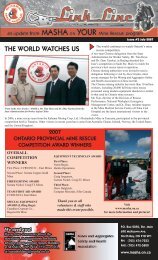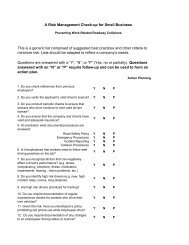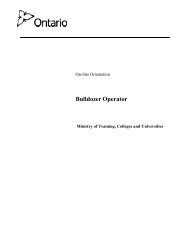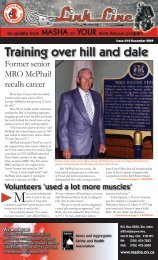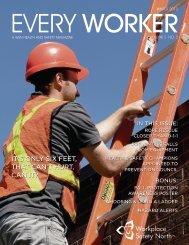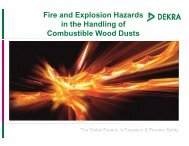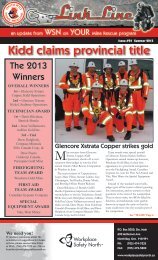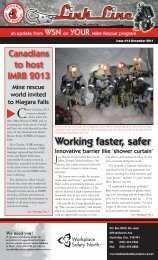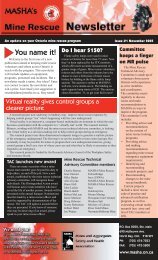a conveyor guard may have saved his life - Workplace Safety North
a conveyor guard may have saved his life - Workplace Safety North
a conveyor guard may have saved his life - Workplace Safety North
Create successful ePaper yourself
Turn your PDF publications into a flip-book with our unique Google optimized e-Paper software.
HAZARD ALERT!<br />
FORESTRY SECTOR<br />
Vehicle carrying tree-thinning crew<br />
narrowly escapes collision with<br />
float truck<br />
WHAT HAPPENED?<br />
A tree-thinning crew was driving on a secondary logging road at the end of the day.<br />
It was wintertime, daylight was fading, 10 cm of fresh snow was on the ground and<br />
more was falling. The crew’s driver, who was on <strong>his</strong> first day in the cutting area, was<br />
not familiar with the road. His vehicle was travelling at about 40 km per hour.<br />
Without being aware of it, the driver reached an intersection with a primary logging<br />
road. A fast-moving truck suddenly came into view on <strong>his</strong> right. The driver braked<br />
hard as the float truck passed in front of him. His vehicle skidded into the intersection<br />
and narrowly missed the rear of the trailer. No one was injured.<br />
WHY DID IT HAPPEN?<br />
When the company inspected the incident site, it realized that there was no sign<br />
warning of the intersection. Because of the time of day, poor weather and the driver’s<br />
unfamiliarity with the route, it was difficult for him to know where the intersection<br />
was. Vegetation had grown in considerably on either side of the approach to the<br />
intersection, further hampering visibility. Another secondary road on the far side of<br />
the intersection made it look like the road continued beyond the intersection. Only<br />
the driver’s moderate speed prevented a devastating collision from happening.<br />
HOW COULD IT BE PREVENTED?<br />
Many serious incidents in forestry operations in recent years <strong>have</strong> involved collisions<br />
on logging roads. The sheer variety of types of vehicles used on these roads increases<br />
the hazards for everyone who drives on them. The condition of the roads further adds<br />
to the risk.<br />
Because of the seriousness of these hazards, Sections 114 to 119 of Regulation 851 for<br />
Industrial Establishments contain detailed requirements concerning logging roads<br />
and the vehicles that are driven on them. For example, Section 117(c)(ii) requires that<br />
all haul roads “<strong>have</strong> signs warning of the approach to every bridge, crossroad, blind<br />
curve, steep grade, and railway crossing”.<br />
Defensive driving practices are essential at all times on logging roads. Employers<br />
<strong>have</strong> a responsibility to ensure that logging roads are well-maintained, including the<br />
brushing of vegetation to improve sightlines. If a driver is unfamiliar with the road,<br />
special care needs to be taken, especially in bad weather and poor lighting. Two-way<br />
radios with which drivers communicate their position on logging roads are another<br />
important tool to prevent collisions.<br />
Defensive driving<br />
practices are<br />
essential at all times<br />
on logging roads.<br />
call us toll free:1-888-730-7821 (Ontario only) www.workplacesafetynorth.ca<br />
T<strong>his</strong> alert is based on an actual incident. If you <strong>have</strong> an incident you’d like to share, please email info@workplacesafetynorth.ca. The description of<br />
circumstances does not reflect legal commentary, nor is it meant to assign legal responsibility to any person or firm.



